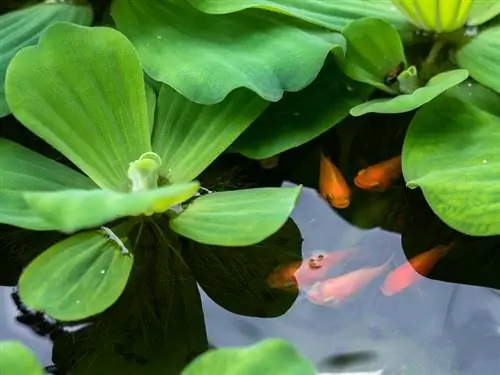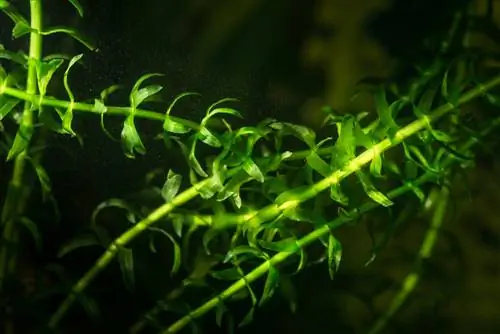- Author admin [email protected].
- Public 2023-12-25 17:45.
- Last modified 2025-01-23 11:22.
Brushes master the permanent and lush greening of ponds, streams, wet meadows and water worlds with flying colors. The robust freshwater grasses are mostly lime-tolerant, clean the water and thrive even in compacted, waterlogged soil. The following answers to frequently asked questions provide everything you need to know about cultivating resilient perennials.

How do you care for rushes in the garden?
Bulrushes are robust freshwater grasses that thrive in ponds, streams and wet meadows. They prefer sunny to partially shaded locations, nutrient-rich, moist to wet soil and can tolerate up to 5 cm of water depth. Your care includes watering, fertilizing and pruning if necessary.
Planting rushes correctly
When planting rushes, pay attention to their tendency to overgrow. To keep the spread under control, place the young plants in the moist, wet soil in the fall along with a sturdy plant basket. If the root ball is in 1-5 cm of water, weigh down the substrate with pebbles so that it is not washed away.
Care tips
If rushes are entrusted with the greening of ponds and streams up to a water depth of 5 cm, watering and fertilizing are not necessary. The only care measure left is pruning in early spring if the perennial has been affected by a harsh winter. Otherwise, comb out the withered leaves with a rake. If the ornamental grass thrives in a pot on the balcony or windowsill, the care program revolves around these points:
- Keep the substrate continuously moist
- Fertilize liquidly every 4-6 weeks from April to September
- Fertilize evergreen species and varieties every 8 weeks in winter
- Topiary cutting is possible at any time if necessary
If the rhizomes threaten to burst the pot after 1-2 years, repot the rushes in spring into a nutrient-rich substrate with the best water storage capacity.
Which location is suitable?
A combination of light and soil conditions defines the ideal location conditions for rushes. We have put together a brief overview of all the important criteria for you here:
- Sunny to semi-shady location
- Moist to wet, nutrient-rich soil
- Loamy-sandy, boggy to swampy soil
- Maximum water depth 5 cm
With a few exceptions, rushes prefer a neutral to alkaline pH value. If the selected location is dominated by acidic soil values, we recommend planting tangle rushes (Juncus conglomeratus) or dwarf rushes (Juncus ensifolius).
What soil does the plant need?
The condition of the soil plays a key role in the successful cultivation of rushes. Choose a location with boggy to swampy soil, preferably loamy-sandy, clayey and rich in nutrients. Robust species, such as the blue rush, are not deterred even by compacted soil. A light to medium lime content is not a problem for the sweet grass. The perennial thrives in moist, wet soil in a water depth of up to a maximum of 5 cm.
Cut rushes correctly
Bulrushes are consistently resilient, so pruning can be carried out at any time. In fact, this measure is only necessary after a very hard winter when bitter frost caused the stalks to die. In this case, cut the ornamental grass close to the ground in spring - in time before fresh shoots appear. In other years, you simply comb through the clumps with a rake to restore the well-groomed appearance. To prevent self-seeding of the vigorous grasses, cut off the inconspicuous flowers in good time before seeds form.read more
Watering the rushes
If you assign your rushes a place in wet meadows or pots, the soil must not dry out at any time. In the best case scenario, the soil surface only dries out a little before you water the grass. In this case, the excess irrigation water may remain in the saucer, as waterlogging is desired.
Fertilize rushes properly
If the general conditions at the location are right, there is no need for additional nutrient supply outdoors. In the bucket on the balcony or in the pot on the windowsill, fertilize rushes every 4-6 weeks with a liquid fertilizer from April to September. Evergreen species and varieties receive a diluted dose of fertilizer every 8 weeks between October and March.
Wintering
Bulrushes are completely frost-resistant and bravely stand up to the icy cold. There are therefore no precautions to be taken for wintering in autumn. The only exception are species and varieties in pots with a diameter of less than 30 cm. High pressure from frozen water could crush the rhizomes. For reasons of caution, move these plants to frost-free, bright winter quarters.
Propagate rushes
Bulrushes can be propagated without much effort. For this purpose it is not necessary to remove the entire plant from the ground. In autumn or spring, use a spade to cut off rhizome pieces that have at least 3-4 leaves. At the new location, place these segments in moist to wet, nutrient-rich soil. It is important to note that the root pieces are planted as deeply into the ground as possible.
Bulrushes in a pot
The striking corkscrew rush has made a name for itself as a decorative and easy-care potted plant. With its evergreen, winding stalks, it stands out impressively both on the balcony and on the windowsill. Any commercially available compost-based potting soil with little or no peat content is suitable as a substrate. Keep the soil constantly moist, allowing the surface to dry briefly. From April to September, apply a liquid fertilizer in a diluted concentration, provided the Juncus has not previously been repotted into pre-fertilized substrate. Shoots that are too long can be shortened at any time. In spring, simply comb or pluck withered leaves from the clump.
Is rushes poisonous?
As part of the large plant family of sweet grasses, the non-toxic rushes pose no he alth risk to humans or animals. The robust ornamental grasses can therefore be planted in the family garden without hesitation.
Trivia
Like no other type of grass, rushes have been the inspiration for many sayings. A general fact is described as a truism, with a view to the worldwide distribution of the plant. Anyone who 'looks for the knot in the bush' suspects problems where there actually aren't any. This expression is derived from the round, knotless stalks of rushes. The saying 'Go into the rushes' is still popular today. This expresses when something is lost or fails. In the 19th century, hunters had this saying on their lips when wild ducks, fleeing from hunting dogs, ran into the rushes standing in the water and could no longer be caught as prey.
Beautiful varieties
- Spiralis: Decorative rush with corkscrew-like leaves and yellow brush flowers in summer; 20-60cm
- Blue Arrows: Stands out with blue-green, round, taut leaves and thrives even in compacted soil; 60cm
- Starhead: Pretty dwarf rush with flat leaves and spherical, brown flowers from June to August; sensitive to limescale; 25cm
- Javelin: Giant rush for large bodies of water, whose blue-green stalks stretch up to 180 cm towards the sky; beautiful solitaire
- Sword-leaved rush: Premium variety with narrow, upright leaves and bushy flowers from June; 15-30cm






